A Timely Discovery: Examining Our AMD 2nd Gen Ryzen Results
by Ian Cutress & Ryan Smith on April 25, 2018 11:15 AM ESTA Timely Re-Discovery
Most users have no need to worry about the internals of a computer: point, click, run, play games, and spend money if they want something faster. However one of the important features in a system relates to how they measure time. A modern system relies on a series of both hardware and software timers, both internal and external, in order to maintain a linear relation between requests, commands, execution, and interrupts.
The timers have different users, such as following instructions, maintaining video coherency, tracking real time, or managing the flow of data. Timers can (but not always) use external references to ensure their own consistency – damage, unexpected behavior, and even thermal environments can cause timers to lose their accuracy.
Timers are highly relevant for benchmarking. Most benchmark results are a measure of work performed per unit time, or in a given time. This means that both the numerator and the denominator need to be accurate: the system has to be able to measure what amount of work has been processed, and how long it took to do it in. Ideally there is no uncertainty in either of those values, giving an accurate result.
With the advent of Windows 8, between Intel and Microsoft, the way that the timers were used in the OS were changed. Windows 8 had the mantra that it had to ‘support all devices’, all the way from the high-cost systems down to the embedded platforms. Most of these platforms use what is called an RTC, a ‘real time clock’, to maintain the real-world time – this is typically a hardware circuit found in almost all devices that need to keep track of time and the processing of data. However, compared to previous versions of Windows, Microsoft changed the way it uses timers, such that it was compatible with systems that did not have a hardware-based RTC, such as low-cost and embedded devices. The RTC was an extra cost that could be saved if the software was built to do so.
Ultimately, any benchmark software in play has to probe the OS to determine the current time during the benchmark to then at the end give an accurate result. However the concept of time, without an external verifying source, is an arbitrarily defined constant – without external synchronization, there is no guarantee that ‘one second’ on the system equals ‘one second’ in the real world. For the most part, all of us rely on the reporting from the OS and the hardware that this equality is true, and there are a lot of hardware/software engineers ensuring that this is the case.
However, back in 2013, it was discovered that it was fairly easy to 'distort time' on a Windows 8 machine. After loading into the operating system, any adjustment in the base frequency of the processor, which is usually 100 MHz, can cause the ‘system time’ to desynchronise with ‘real time’. This was a serious issue in the extreme overclocking community, where world records require the best system tuning: when comparing two systems at the same frequency but with different base clock adjustments, up to a 7% difference in results were observed when there should have been a sub-1% difference. This was down to how Windows was managing its timers, and was observed on most modern systems.
For home users, most would suspect that this is not an issue. Most users tend not to adjust the base frequencies of their systems manually. For the most part that is true. However, as shown in some of our motherboard testing over the years, frequency response due to default BIOS settings can provide an observable clock drift around a specified value, something which can be exacerbated by the thermal performance. Having a system with observable clock drift, and subsequent timing drift, is not a good thing. It relies on the accuracy and quality of the motherboard components, as well as the state of the firmware. This issue has formally been classified as ‘RTC Bias’.
The extreme overclocking community, after analysing the issue, found a solution: forcing the High Performance Event Timer, known as HPET, found in the chipset. Some of our readers will have heard of HPET before, however our analysis is more interesting than it first appears.
Why A PC Has Multiple Timers
Aside from the RTC, a modern system makes use of many timers. All modern x86 processors have a Time Stamp Counter (TSC) for example, that counts the number of cycles from a given core, which was seen back in the day as a high-resolution, low-overhead way to get CPU timing information. There is also a Query Performance Counter (QPC), a Windows implementation that relies on the processor performance metrics to get a better resolution version of the TSC, which was developed in the advent of multi-core systems where the TSC was not applicable. There is also a timer function provided by the Advanced Configuration and Power Interface (ACPI), which is typically used for power management (which means turbo related functionality). Legacy timing methodologies, such as the Programmable Interval Timer (PIT), are also in use on modern systems. Along with the High Performance Event Timer, depending on the system in play, these timers will run at different frequencies.
The timers will be used for different parts of the system as described above. Generally, the high performance timers are the ones used for work that is more time sensitive, such as video streaming and playback. HPET, for example, was previously referred to by its old name, the Multimedia Timer. HPET is also the preferred timer for a number of monitoring and overclocking tools, which becomes important in a bit.
With the HPET timer being at least 10 MHz as per the specification, any code that requires it is likely to be more in sync with the real-world time (the ‘one-second in the machine’ actually equals ‘one-second in reality’) than using any other timer.
In a standard Windows installation, the operating system has access to all the timers available. The software used above is a custom tool developed to show if a system has any of those four timers (but the system can have more). For the most part, depending on the software instructions in play, the operating system will determine which timer is to be used – from a software perspective, it is fundamentally difficult to determine which timers will be available, so the software is often timer agnostic. There is not much of a way to force an algorithm to use one timer or another without invoking specific hardware or instructions that rely on a given timer, although the timers can be probed in software like the tool above.
HPET is slightly different, in that it can be forced to be the only timer. This is a two stage process:
The first stage is that it needs to be enabled in the BIOS. Depending on the motherboard and the chipset, there may or may not be an option for this. The options are usually for enable/disable, however this is not a simple on/off switch. When disabled, HPET is truly disabled. However, when enabled, this only means that the HPET is added to the pool of potential timers that the OS can use.
The second stage is in the operating system. In order to force HPET as the only timer to be used for the OS, it has to be explicitly mentioned in the system Boot Configuration Data (BCD). In standard operation, HPET is not in the BCD, so it remains in the pool of timers for the OS to use. However, for software to guarantee that the HPET is the only timer running, the software will typically request to make a change and make an accompanying system reboot to ensure the software works as planned. Ever wondered why some overclocking software requests a reboot *before* starting the overclock? One of the reasons is sometimes to force HPET to be enabled.
This leads to four potential configuration implementations:
- BIOS enabled, OS default: HPET is in list of potential timers
- BIOS enabled, OS forced: HPET is used in all situations
- BIOS disabled, OS default: HPET is not available
- BIOS disabled, OS forced: HPET is not available
Again, for extreme overclockers relying on benchmark results to be equal on Windows 8/10, HPET has to be forced to ensure benchmark consistency. Without it, the results are invalid.
The Effect of a High Performance Timer
With a high performance timer, the system is able to accurately determine clock speeds for monitoring software, or video streaming processing to ensure everything hits in the right order for audio and video. It can also come into play when gaming, especially when overclocking, ensuring data and frames are delivered in an orderly fashion, and has been shown to reduce stutter on overclocked systems. And perhaps most importantly, it avoids any timing issues caused by clock drift.
However, there are issues fundamental to the HPET design which means that it is not always the best timer to use. HPET is a continually upward counting timer, which relies on register recall or comparison metrics rather than a ‘set at x and count-down’ type of timer. The speed of the timer can, at times, cause a comparison to fail, depending on the time to write the compared value to the register and that time already passing. Using HPET for very granular timing requires a lot of register reads/writes, adding to the system load and power draw, and in a workload that requires explicit linearity, can actually introduce additional latency. Usually one of the biggest benefits to disabling HPET on some systems is the reduction in DPC Latency, for example.


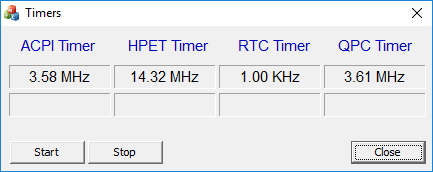
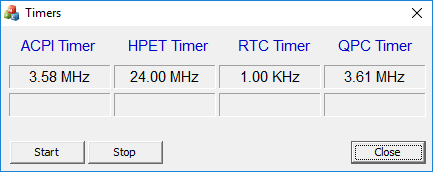
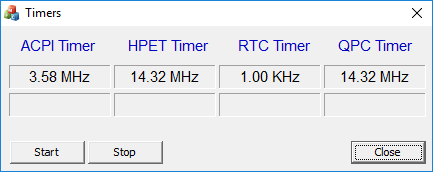
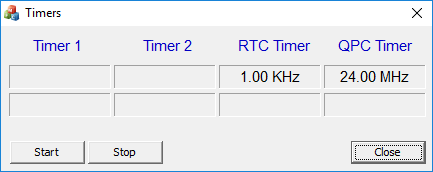
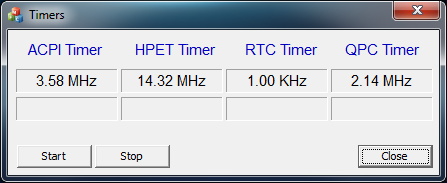
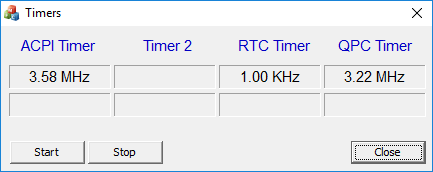








242 Comments
View All Comments
Lord of the Bored - Thursday, April 26, 2018 - link
Not just nVidia. AMD's graphics division has been known to do it too, going back to when it was still an independent company. See: QUAFF3.EXEMaxiking - Saturday, April 28, 2018 - link
Yeah like AMD was using less demanding tessellation to boost their score in benchmarks or less demanding AF ignoring completely what an application set. . Oh yeah, I forgot, when the same thing happened to AMD, it was a bug, when to Nvidia, cheating. Those double standards are hilarious.Fallen Kell - Wednesday, April 25, 2018 - link
The overhead of HPET causes the Intel CPUs to effectively slow down with the combination of the Meltdown+Spectre fixes. HPET is a system call which results in the harshest penalty of the fixes for Meltdown+Spectre. Add to the fact that Intel's implementation of HPET is higher fidelity (i.e. higher speed clock rate) than the specification requires, and then combine that higher fidelity with creating an even larger load on the CPU (due to Meltdown+Spectre), and it creates the large performance degradation.The other timers (TSC + lapic) do not incur as high a penalty, as these do not result in system calls which need to be protected from Meltdown/Spectre exploitation.
mczak - Wednesday, April 25, 2018 - link
The higher clock the HPET runs at for intel should make absolutely no difference - it's the cost of reading the timer which counts, the rate it's running at should not be relevant. (Although I higher frequency may have higher hw implementation cost.).For this kind of slowdown as shown in some games though there have to be LOTS of timer queries. But I suppose it's definitely possible (I suspect nowadays everyone uses the TSC based queries and forget to test without them being available), which are much faster in hw and don't require syscalls. Meltdown (and probably to a lesser degree Spectre) could indeed have a big impact on performance with HPET (if there's that many timing queries). I'd like to see some data with HPET but without these patches.
looncraz - Wednesday, April 25, 2018 - link
I believe, from my own testing, that it's merely a factor of reporting. HPET has always resulted in a smoother, faster, system with less stutters when I enable it.I also use SetTimerResolutionService to great effect.
tamalero - Thursday, April 26, 2018 - link
Its interesting how it is very different from person to person.I usually had HPET on with my intel Quadcores..
But once I got my Threadripper I had to disable and remove HPET. If not I would get horrible stuttering.
GreenReaper - Friday, April 27, 2018 - link
It may be more *responsive*, yet able to do less work. In fact, speed and latency can be opposites - if you never pick your head up while doing a task, you'll probably execute it in the fastest possible time, at the expense of anything else that you might have wanted to do during that time. Most interactive users don't appreciate the computer not paying attention to them, so desktop computers tradeoff for speed for reduced latency - although with multi-core systems the impact is small.In the past when the TSC was not present, HPET also moved the system more towards being a real-time system, and the cost of that the overhead of the more frequent timer checks. Nowadays, especially with nonstop TSC (not impacted by power management), I'm not sure that is the case, but using it might still change latency - for good or ill.
Enabling HPET does not mandate forcing its use over the alternatives, but mandating it with 'bcdedit /set useplatformclock true' does. You can do the equivalent on Linux. And clearly, there is a cost, although that cost varies greatly depending on the platform and what you are doing.
Over the years I've seen numerous cases of people trying to reduce the number of gettimeofday calls to increase performance, and the cost of checking the HPET is probably one of the reasons.
Ryan Smith - Thursday, April 26, 2018 - link
"But is there a 'real' performance impact or does default HPET behavior simply introduce a fudge factor that alters how the tools report the numbers? Is there a way to verify the results externally?"Yes, you can compare the clocks with various applications, including the Timers applications. Which in our case shows that neither the ACPI nor QPC timers are drifting versus the HPET timer. So the performance difference really is a performance difference, and not a loss of timer accuracy.
https://images.anandtech.com/doci/12678/TimerBench...
chrcoluk - Wednesday, April 25, 2018 - link
Disabling TSC is a big nono.Forced HPET as an example will disable optimised interrupts for network cards, the AMD and intel review support staff probably dont have the knowledge to correctly advise you. I suggest you contact microsoft.
Also your cpu's tested, what decides what cpu's you decided to compare to? the AMD review guide or something else? Was a lot of omitted CPU's and noticeably no manual overclocked intel cpu's in your data.
See my first reply, if AMD software is forcing HPET and especially if they not informing the user the consequences of doing this then thats very irresponsible.
eddman - Thursday, April 26, 2018 - link
Some rather interesting info on timers from MS: https://msdn.microsoft.com/en-us/library/windows/d...